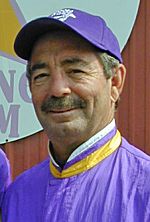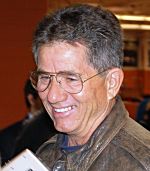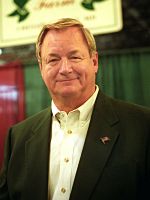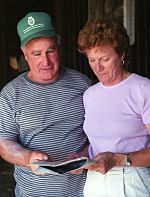Harness racing salutes Veterans
November 11, 2009,by Ellen Harvey, Harness Racing Communications
Editor’s Note: The USTA salutes and celebrates the sacrifice and service of all veterans, both those with us now and those who gave their lives to defend our country. There are doubtless thousands of people in racing who completed military service. Though we can profile just a few, we are grateful and proud of them all.
Freehold, NJ — As the United States celebrates Veteran’s Day today, there are millions of men and women to thank for their service to our country. Although most in harness racing think of a “vet” as someone to be called when a horse is sick, those that served our country can be found in every facet of racing.

Dick Stillings
Dick Stillings sent out back-to-back winners in the Little Brown Jug (Barberry Spur in 1986 and Jaguar Spur in 1987), but in the fall of 1962, he was a restless young man, uncertain of a direction to take in life.
“It was the Cuban Crisis (a confrontation between the US, Cuba and the Soviet Union with threat of imminent nuclear war) and the draft was on,” he says. “I decided I would enlist, to have some selection in what I wanted to do. I graduated from high school in ’62, I worked for (trainer) Dick Buxton that summer and I decided to go in the army.
“I went to jump school. I don’t know why I did that. The guys in there asked me, ‘Why are you here, as small as you are?’ (Stillings is under 5’7”). We didn’t make any combat jumps, just “pay” jumps; you had to jump every three months to stay certified. I wanted to be a paratrooper because they gave you more money. It was maybe $50 a month. In the ‘60s that was a lot of money.”
In the mid ‘60s the war in Vietnam was escalating and Stillings was on the first troop ship west. He’d also made a fortuitous change in his military job.
“I changed my job status when I went to rigger school, packing parachutes,” he recalls. “It probably saved my life, kept me out of combat. We stayed behind the lines and supported the troops on the front lines.”
Stillings likens packing parachutes to the routine of harnessing a horse.
“Once you start doing it, you know what’s right and what’s wrong. I was there the last six months of my duty, just before 1966. When I went over there we had 60,000, 70,000 troops. When I left, we had 170,000.”
Even in the waning days of 1965, in his early 20s, Stillings recognized the value of his experience as he rejoined the horse business.
“Things got a lot easier for me after I came home,” he recalls. “I didn’t worry so much about how things were going. When you’re over there and see how people live their lives, our world over here, regardless of how you’re doing, you’re still on top by their standards.”
As Dick Stillings was leaving Vietnam in 1965, Ed Lohmeyer was realizing there was no way out of going there. Ed Lohmeyer is now known as the trainer of horses like multimillionaire Pacific Fella and top trotting mare Classic Lane, but in 1965 he was a young man trying to get a stable to the races. The Monticello (NY) Draft Board had other ideas.

Ed Lohmeyer
“I had seven horses that were ready to start racing,” Lohmeyer said. “The local board gave me a deferment for a year, so I had a year to race the horses and get rid of them. I knew it (the war) wouldn’t be over, the Vietnam War was raging. I knew I’d go in.
“There were 76 of us that went to Whitehall Street (in New York City) on a bus. They needed seven for the Marine Corps and I was one of the two that volunteered. I figured if I was going in the service, I’m going to go with the best. I wanted people that knew what they’re doing and guys that are dedicated standing alongside me. You knew where you were going. You were going to Vietnam. They were taking everyone then, even if you only had one leg, they were taking everybody.”
Lohmeyer’s late father, Ed Sr., a former Air Force pilot, not only introduced him to horses, but to airplanes as well; that background came out in the aptitude tests he took in the service.
“At boot camp I had an offer from Uncle Sam to be one of the two or three people in my platoon sent to flight school to be a pilot,” Lohmeyer said. “I would have to sign up for five more years to do that, because they spend a million dollars or so training you. I just didn’t think I wanted to do that. I got a taste of the horses and I didn’t think I wanted to sign up for five more years to be a pilot. I don’t know if I made the right move or not, because I love to fly. I flew with my dad all the time; I wasn’t flying by myself then.”
Lohmeyer obtained licenses to fly planes and helicopters after his discharge and has been active in that regard for decades.
After a short stint in engineer training, Lohmeyer shipped out to Da Nang, Vietnam, where he spent 13 months in a single tour of duty.
“When they blew the bridges up, we put pontoon bridges in,” he said.
His contact with the rest of the world was infrequent; his contact with the harness racing world nonexistent. The racing news he got was “only what someone wrote you from home. There were no newspapers, no Internet back then. We were way out, we never had anything to eat other than something from a can for six or seven months; then we got kind of a mess hall and milk.”
Discharged and back to his horses at age 25, Lohmeyer looks past his accomplishments in harness racing to declare, “The proudest thing I am is a former Marine. It just makes you a better person, no doubt. Nobody wants to go into a war or a place like that. But you can just about live in any kind of conditions or put up with the good or bad for the rest of your life with no problem. I was real, real lucky. I wasn’t an infantryman out in the field. I didn’t see the real bad stuff.”
As owner of Winbak Farm with his wife Joann, Joe Thomson oversees a prolific Standardbred breeding farm that produced nearly 1,000 starters last year, as well as Horse of the Year favorite Muscle Hill. But when he graduated from Transylvania College in Lexington, Kentucky, the ink was barely dry on his diploma before he was drafted during the Vietnam War.

Joe Thomson
“I graduated on the 10th of June and I was in the Army by the 3rd of July,” recalled former Lt. Thomson. “I volunteered for Officer Candidate School. I came out a Forward Observer, the guy who stands on the hill and directs artillery and air power. Most people had joined, but I was a draftee. I volunteered for everything, airborne, ranger, whatever they wanted. I guess they must have thought I was crazy. My whole class went to Vietnam.
“They gave you the papers asking what you’d like to do, which was really a joke because everybody was going (to Vietnam). I said I’ll do airborne, ranger, special forces, anywhere you want me to go, but I’m not going to make the military a career. (I told them) if they had anything in sales or marketing, I’d be good in that also. And that’s how they chose me. I was in the recruiting business.”
And so it was that Thomson went not to Vietnam, but Baltimore. He ended up using evasion tactics and dealing with hostility, not from an enemy combatant, but from fellow citizens.
“All I did was recruit officers for the United States Army during the Vietnam War,” he said. “I was at Fort Holabird, Baltimore, Maryland.
“We went to colleges; there were demonstrations all over the place. Between ’67 and ’69, that was the heart of the Vietnam War. When we saw big trouble coming, we could be out of there very fast. If you were in trouble arguing about the war, the other guy (fellow recruiter) would come in and deflect them. The other person would take on the group, the person who’d been in the argument would pack up and we’d be out of there. We had it down to a science.”
With decades to reflect on the experience, Thomson says his days pushing against the tide of a deeply emotional and divisive war gave him a sense of equanimity that persists to this day.
“When you see people who are passionate about what they believe, you know there is no way to change their mind,” Thomson said. “You are gaining nothing by getting in a passionate argument with them.”
In life, as in racing, timing is everything. Charlie “Chaz” Norris knows that better than most. He’s the son and assistant trainer for Charlie Norris, a Meadows-based trainer who has teamed up with his father on the likes of stakes-winning trotters Foggy Lane K, Lovin Every Moment and Captain Brady. In 2001, Chaz Norris was a new high school graduate uncertain about his future.
“I didn’t really know what I wanted to do and didn’t know if horses were what I wanted to do,” said the younger Norris. “I figured instead of going to college and wasting money, I’d go into the service and get paid for going to college.”
In June 2001, the world had not yet been rocked by the events of September 11, 2001 and the 18-year-old Norris was not drawn to military service by patriotism, but rather as a means to figure out the course of his life.
“If I liked it I was going to stay in, if I didn’t I was going to try to figure out what I wanted to do,” he said. “You can do two-, four- or six-year enlistments. I did six years because they gave me a signing bonus of $6,000. I was in my second week of tech school at Lackland Air Force Base in San Antonio, where they teach you your job, during September 11.”
Days before September 11, Norris was consoling his worried mother.
“I said, ‘Mom, who’s going to attack us, seriously?’ And then September 11 happened,” he said.
For the next six years, save a few trips to Cal-Expo while stationed at Travis Air Force Base, Norris’ life was defined not by post time and feed time, but by 12-hour shifts, loading cargo on planes.
“I was an aerial transporter, I loaded planes, cargo, munitions, anything you can put on a plane, I put on,” he said. “For a while, I was only loading explosives. I drove a loader some days and some days I pushed. Some days it was back breaking.
“I deployed four times. I was in Seeb, a little country on the Gulf Coast, near Qatar and the United Arab Emirates, from there I forward deployed to Qatar. In 2004, I went to Kyrgyzstan near China, and my last deployment was to Kuwait City.”
Though the work hours were long and home was far away, Norris said he was never under attack.
“I heard shots, but I don’t think I was ever shot at,” he said. “I was always on an American Air Force base. We were sending to Iraq or Afghanistan; it was going there to be used.”
Norris, who recently obtained a provisional license to drive the stable’s 35 horses, says military service did give him the clarity he sought to determine a career path.
“I knew about two days into basic training, ‘Man, racing horses does not look too bad,’” he said with a laugh. “I ended up coming back to the horses. I grew up more in the first six weeks after I left. I’d come home to visit and my friends were partying. I’d say, ‘Yeah, no thanks.’ I really think it will only help. I don’t worry about things that are not that important. The stuff I can’t control, I don’t worry about. That is the main thing I stick to.”
While Chaz Norris’ timing couldn’t have been worse, Frank Ingrassia’s was perfect.

USTA photos
Frank and Jacqueline Ingrassia
Ingrassia trains a boutique stable of trotters alongside his wife, Jacqueline, and the duo is perhaps best known for sending out Goalfish, with whom Mrs. Ingrassia became the first woman to win a Triple Crown event, the 2000 Yonkers Trot.
Frank Ingrassia was a bricklayer in 1953, building houses in the post-World War II housing boom, when he made an abrupt career change.
“That was Uncle Sam’s idea,” he says. “I got drafted, I was about 21 and went to 39 Whitehall Street in New York City with a little suitcase with toothpaste and shaving cream and that was it.”
While Ingrassia left horses behind, they were his father Charles’, not his.
“My father had a riding academy, 150 horses in Flushing, Queens,” said Ingrassia. “He had some harness horses and flat (Thoroughbreds), too. I wound up in infantry in Camp Polk, La.”
Ingrassia was drafted around the time an armistice was reached between North and South Korea in July of 1953, followed by de-escalation of the war.
“The class that was just finishing basic training before me went to Korea after an eight-week training course,” says Ingrassia. “We had a 16-week course, they had eight weeks and were sent overseas. We never went.
“We got shipped to Ft Bragg, N.C. for extensive training. By that time, the war was near the end and we didn’t go. Once I got in, they surrendered,” he laughed.
